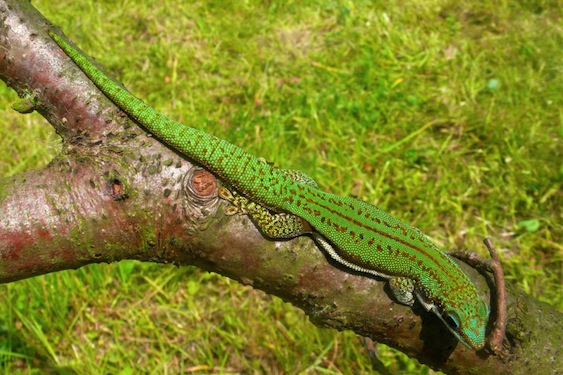
Image © Emmanuel Van Heygen
Description
Phelsuma malamakibo, is a medium-sized day gecko. It is identified by the presence of a distinct dark lateral stripe on the neck and body with a white lateral stripe beneath it and a second, thin dark lateral stripe below the white stripe; greenish dorsal ground color with reddish brown spots arranged into three longitudinal rows or lines on the neck and back; no sexual dichromatism; a median cleft dorsally on the rostral scale; nostrils centered above the first supralabial scale; subequal subcaudal scales; keeled gular and anterior chest scales; and smooth (unkeeled) scales on the ventral surfaces of the body and tail. In most respects, this new species is similar to Phelsuma lineata, P. pusilla, and P. quadriocellata; however, these species have keeled ventral scales. Phelsuma malamakibo is similar to P. modesta in having smooth ventral scales, but the latter species is sexually dichromatic and differs from P. malamakibo in details of coloration and nostril position, as well as habitat. Phelsuma modesta is largely arboricolous in variable, usually drier habitats, whereas P. malamakibo is saxicolous in rain forest.
Etymology
The name "malamakibo" is Malagasy for "smooth-belly"
Distribution
Phelsuma malamakibo is a rock-dwelling species which occurs in primary rain forest on the eastern slopes of the Anosyenne Mountains, at elevations between 810 m and 1940 m in Réserve Naturelle Intégrale d'Andohahela, southern Madagascar.
Terra Typica
13.5 km northwest of Eminiminy, 1200 m elevation, 23°35.04'S, 46°44.08'E
Biotope
Phelsuma malamakibo lives on rocks between 870 m and 1940 min the primary evergreen rain forest or montane grassland and heathland. At lower elevations the species is found in open forest areas near riverbanks and along streams. At higher altitudes, where the forest is less dense and has more open areas, Phelsuma malamakibo is widely distributed in these montane habitats where rock substrate is available.
Biology
The eggs are attached firmly to the rocks. Nesting sites are often used by several females.
Refferences
Nussbaum, Ronald A., C.J. Raxworthy, A.P. Raselimanana, and J.B. Ramanamanjato (2000): New Species of Day Gecko, Phelsuma Gray (Reptilia: Squamata: Gekkonidae), from the Reserve Naturelle Integrale d'Andohahela, Southern Madagascar Copeia 2000(3):763-770.
